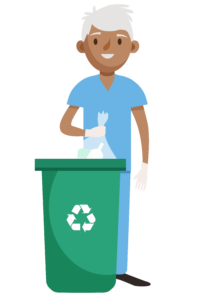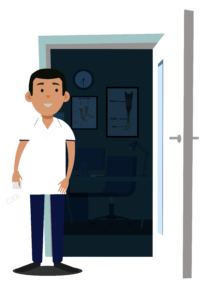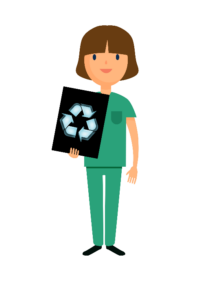Reducing the environmental impact of equipment, medicines and resources
Where you can make a positive impact towards net zero
AHPs and their teams should reduce the environmental impact of equipment and resources by:
- Considering the ‘5 Rs’ questions, in order of priority, when selecting equipment for equipment contract catalogues: ’Reduce, Reuse, Reprocessed, Renewable, Recycle’
- Where possible, actively involving themselves in the tendering for equipment contracts.
- Evaluating the energy use of any equipment or technology and ensure that good practice in terms of reducing energy use is adopted. This could be as simple as turning off equipment when not in use, or coordinating treatment times to ensure machinery is not idle for long periods
- Ensuring efficient use and safe disposal of medical gases and anaesthetic agents with high global warming potential such as nitrous oxide (paramedics, operating department practitioners) and sulphur hexafluoride (Rradiographers)
- Continuing to prevent over prescription of equipment. AHPs play a key role in the reduction of over-prescription of equipment
- Encouraging patients to return prescribed equipment to the hospital if a refurbishment scheme is available, or to recycling centres and key drop off points so equipment can be collected, reducing mileage to each individual’s house and optimising potential for reuse.
AHPs in leadership or management roles should:
- Where possible, actively involve themselves in the tendering for equipment contracts. Within that process they should:
- ensure environmental impact and sustainability are scored criteria within the tendering process and core requirements within the contract, drawing on best practice from existing contracting approaches
- utilise AHP knowledge of equipment to ensure processes/services are in place to optimise the reuse and recycling of equipment
- incorporate strategies to optimise reuse of standard and non-standard equipment
- utilise recycling incentives and key performance indicators (KPIs) to optimise recycling and reuse rates
- Engage with suppliers to encourage more transparency on sustainability information and develop innovations to reduce carbon emissions from equipment
- Introduce procedures to ensure that finite resources are used with minimal waste – which has the dual impact of reducing financial and environmental cost.
 The NHS’ supply chain accounts for 66% of the overall carbon emissions. This covers a wide range of goods and services, including medicines, medical and non-medical equipment. For most of these emissions, the NHS does not have direct control but has a considerable influence through its purchasing power.
The NHS’ supply chain accounts for 66% of the overall carbon emissions. This covers a wide range of goods and services, including medicines, medical and non-medical equipment. For most of these emissions, the NHS does not have direct control but has a considerable influence through its purchasing power.
The phrase ’Reduce, Reuse, Reprocess, Renewable, Recycle’ applies here, as there are numerous ways in which AHPs can alter the way they procure, use and dispose of equipment and resources in order to reduce environmental impact and in particular carbon use.
AHPs already play an important part in reducing avoidable use of equipment, medicines and resources by speeding recovery or diagnosis, meeting the needs of people experiencing frailty or reduced mobility, preventing accidents or ill health and maintaining independence and dignity. This must be considered when making decisions about AHP equipment or resource use.
 Reducing energy, resource and equipment use
Reducing energy, resource and equipment use
Energy use
AHPs operate in an increasingly digital healthcare landscape, with new technologies and treatments being introduced to improve patient outcomes. However, these technologies have implications on energy consumption, which is particularly significant if that energy is produced by fossil fuels.
For example, diagnostic radiographers and therapeutic radiographers use complex machinery with a high-power demand in a technologically and IT driven environment. This contributes significantly to the carbon footprint and use of resources in clinical imaging and radiotherapy services.
The more extensive and earlier involvement of radiologic investigation in the diagnostic care pathway has resulted in increased demand for diagnostic radiography which is expected to continue (Halliday et al, 2020). Incidences of cancer have increased 16% since the 1990s with a large proportion of these requiring treatment with radiotherapy.
The NHS Long Term Plan sets an ambition to ensure the proportion of cancers diagnosed earlier is increased. This will be beneficial to sustainability requiring fewer and less aggressive interventions.
The simple action of switching imaging equipment or radiotherapy equipment and computers off when not in use (and where this is supported by the manufacturer) can contribute significantly to reduced power use.
Seeking alternatives to resources or equipment that are lower impact can be interpreted in multiple ways. For therapy related professions, utilising nature and the outdoors has the benefit of using less energy and enabling AHPs to support their patients to better understand and interact with the natural world, which may be a means to improve their own sustainability.
 Resource use
Resource use
AHPs frequently use or prescribe resources such as chemicals, mobility equipment or disposable PPE that are not reusable for reasons of clinical safety. Therefore, reducing overall use is a key means of reducing environmental impact. Some of these items can have very significant environmental impacts even in small quantities. For example, radiographers should ensure efficient use of greenhouse gases used in diagnostic processes such as sulphur hexafluoride, which has a global warming potential 23,000 higher than CO2.
Example – Contrast media
Radiographers use iodinated contrast media to delineate vessels and organs in diagnostic imaging examinations and radiotherapy planning. Iodine is a finite resource and production of iodinated contrast media has an impact on the carbon footprint of the healthcare system. Every effort should be taken to use iodinated contrast media in a sustainable way. This reduces environmental impact by using the existing distribution routes and preventing unnecessary import of iodine. It also ensures appropriate disposal of unused contrast media and reduces the impact on soil and water cycles. Techniques to reduce dosage and increase image quality continue to be developed further reducing the use of this resource.
Example – Inhalational anaesthetic agents (IAAs)
Inhalational anaesthetic agents (IAAs) and gases like nitrous oxide have a particularly high carbon footprint, with 5% of the carbon footprint for acute organisations and 2% for the NHS as a whole being from anaesthetic gases. Operating department practitioners can play an important role alongside anaesthetists in raising awareness of more sustainable anaesthesia to reduce this impact, such as by ensuring that the nitrous oxide supply is switched off when not in use and is used sparingly, by supporting a move away from desflurane in favour of sevoflurane or local, regional or total intravenous anaesthesia (TIVA), and by promoting the use of low gas flow rates.
For items that are prescribed to patients, ensuring a personalised approach, which is a key target of the Long Term Plan, can reduce unnecessary equipment use.
Example – Mobility equipment
Occupational therapists and physiotherapists can ensure that mobility equipment is issued with consent and motivation of the individual and their carer (where applicable) to use the equipment. When an individual has capacity to make an informed decision about their equipment and wishes not to accept equipment, positive risk taking is encouraged and a strengths-based approach should be adopted, issuing information to signpost the individual family and and/or their carer (where applicable) if they should change their mind about the equipment.
 Reusable versus single use
Reusable versus single use
Single use
The term “single-use” identifies that an instrument or piece of equipment is intended to be used on an individual patient during a single procedure and cannot be re-used and must thereafter be disposed of. In some cases, even if only the sterile packaging has been opened but the instrument or equipment has not been used, it must still be disposed of as they should not be re-sterilised.
Moving to reusable versions of equipment needn’t change therapy that can be offered and may indeed improve it.
AHPs can also aid reuse of equipment that is prescribed. AHPs can ensure that where reusable equipment has been prescribed and is no longer required, the prescriber or service-user can contact the provider who issued their equipment to begin the reuse process. This involves collection, decontamination, inspection, and if practical, refurbishment. One of the key interventions mentioned in the Delivering a Net Zero NHS reportis the implementation of walking aids refurbishment schemes. The target is to have 40% of all walking aids refurbished in the next five years. A number of professions could liaise with their procurement team to set up a scheme in their trust.
If reusable is generally more carbon-efficient than single-use, any decision to change equipment to reusable must be made with the procurement team, considering the impact on clinical outcomes, costs and carbon emissions
Examples – Communication aids
For speech and language therapy, communication aids can be made reusable, and their lifespans increased relatively easily. Digital communication aids may have longer lifespans than more analogue predecessors and offer further features. This must be balanced against their increased cost and the environmental impact of powering/maintaining them.
Examples – Single use instruments
In podiatry, single use instruments are mostly disposed of by placing them in sharps type containers, most of which are then incinerated. Suppliers of single use instruments often state that the instruments can be recycled but do not offer this service as part of a whole package of instrument provision. An alternative would be to procure reusable instruments.
Although the difference in environmental impact is clear, reusable instruments are significantly more expensive. As a result, research has found that single use continues to be favoured, as the overriding driver at a local level is cost of procurement, with no appreciation of the issues of sourcing or disposal (Ducas, 2018). AHPs need therefore to help communicate the benefits of a re-usable approach.
 Recycling and disposal
Recycling and disposal
Whilst it is not feasible to recycle or reuse some products, for example chemicals, wherever possible this should be done in a sustainable fashion, recycling as much material as possible.
If resources must be disposed of rather than reused or recycled, AHPs can reduce the impact of disposal. This will often mean carefully considering what is procured in the first place to ensure it can be disposed of in a way that will minimise environmental impact.
Ensuring equipment or resources that are procured are recyclable and even including recycling as part of equipment contracts is a route that has been successful. Key performance indicators (KPIs) are commonplace in many equipment contracts in relation to recycling rates – on average recycling KPIs are 90+%, which are often achieved. Some community equipment commissioners report recycling rates are as high as 96% by adopting strategies such as physically inspecting any item over the cost of £50 to assess/optimise its potential for reuse.
AHPs can themselves also make use of recycled material.
Examples – recyclable material
Art Therapists for example can access materials from suppliers or charities that recycle or repurpose arts materials.
For contrast media used by radiographers, many suppliers offer a recycle scheme for unused media. It can be bottled and returned where the iodine is extracted and re-used.
